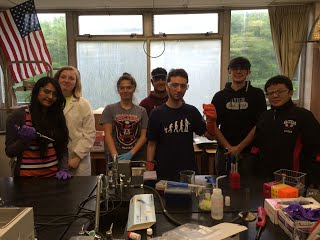Team:WalthamHS BioHawks
From 2014hs.igem.org
(→Design) |
(→Design) |
||
| Line 100: | Line 100: | ||
(Promoter + RBS) + (BB-prefix + OmpA + Pro-sequence + Subtilisin + Terminator + BB-Suffix) | (Promoter + RBS) + (BB-prefix + OmpA + Pro-sequence + Subtilisin + Terminator + BB-Suffix) | ||
| - | [[File:gene.jpg]] | + | [[File:gene.jpg|center]] |
| + | |||
| + | |||
| + | |||
Basic Descriptions: | Basic Descriptions: | ||
Revision as of 14:58, 18 June 2014
| You can write a background of your team here. Give us a background of your team, the members, etc. Or tell us more about something of your choosing. | ||
|
Tell us more about your project. Give us background. Use this as the abstract of your project. Be descriptive but concise (1-2 paragraphs)
TeamOur team consists of students currently enrolled in AP Biology and a few aspiring Biology students. Once we were introduced to the idea of iGEM, people who enjoy science and wanted a hands on experience in laboratories came together to form the BioHawks team. Our team consists of a 8 students, our biology teacher, and a parent who is serving as our advisor.
Micheal Perlow: I am a recent graduate of Waltham High School, in the class of 2014. Being naturally curious, especially in the sciences, I take a particular liking to biology. Last summer, I worked with a graduate student in the Biochemistry department at Brandeis University. Dealing with molecule-interactions (between RPS30B RNA and the u1 snRNP protein), we transformed bacteria and yeast to produce the desired nucleotides or polypeptides. Using that experience combined with the AP Biology class under Mrs. Maddox taken in the 2013-2014 school year, I have developed skills and experience highly adequate for use in synthetic biology. Role: Lab technician and wiki editor. Edward Lo: Hi, my name is Edward Lo and I am currently a junior at Waltham High school. My hobbies include playing the piano and playing tennis. I decided to join to iGEM Club because it interested me in how high school kids could customize their bacteria to perform different tasks. My job on the team is to do lab work and to provide help in the wiki and other things that need to be done. Role: Lab technician and wiki editor. Mina Antic: Hi! I’m a junior at Waltham High School, and always been interested in the sciences (the reason why I’m in the Synthetic Bio Club and why I’m working on this team). Biology is probably (read: definitely) going to be my major when I leave high school and I thought this project would be a good experience. But besides that, I enjoy playing volleyball, painting, and sleeping. Particularly sleeping, which I don’t do as much as I want to. Role: Lab technician and wiki editor. Molly Wack: My name is Molly Wack, and I’m a junior at Waltham High School. I joined this club because I think synthetic biology is a rapidly growing field and it’s an exciting time to join it. In my free time I like to nap and eat, and I like to play basketball and lacrosse too. Role: Wiki editor. Leon Mamish: I am Leon Mamish take out the student and what do you get? Genius, Billionaire, Playboy (ok not really), Philanthropist. But seriously, I am a student at Waltham High School interested in the sciences, specifically Biology and Chemistry. I joined the iGem Team due to my strong interest in Biology and plan to peruse a career in science. My hobbies include sleeping, watching movies, sports and eating. Also, sleeping. Role: Lab technician and wiki editor. Jason Gonsalves: I’ve always had a peculiar interest for science. I’ve completed Environmental Science, Biology, Chemistry and AP Biology in high school and my interest has only grown stronger. When I heard about Synthetic Biology Club, I just had to check it out to sate my pursuit of the field. I love biology specifically and wish to pursue a carrier in it. My other hobbies are track and field, writing and sleeping. Role: Lab technician Marisa Maddox: I have been teaching high school biology at Waltham for seven years. I received my Bachelor's and Master's degrees in microbiology from UMASS Amherst. In my free time I enjoy spending time with my family, traveling and sleeping. Role: Instructor Edward Wack : I am an adviser to the Waltham BioHawks iGEM team. When I'm not coaching youth sports or gardening and doing yard work, I lead the Bioengineering Systems and Technology Group at MIT Lincoln Laboratory. Role: Advisor
ProjectThroughout the fall, and into the winter, our team created a list of many possible topics for our project. We had narrowed our list down to five possible subjects: a pH sensor for tap water at our school, an environmentally friendly paper towel degrader, a stain remover for protein based stains, a pre-food taster that could detect any possible pathogens, and a more effective anti-allergy molecule. After a long discussion of the pros and cons of each topic, the team narrowed the debate to two topics: the pH sensor and the stain remover. There was much lobbying and back and forth before the majority of people voted for the stain removal project. And so began our journey. Our project was to create an environmentally friendly alternative to the harsh chemicals in modern detergents. More and more people every day are developing negative side effects from the continuous use of the damaging chemicals. Laundry detergents can cause such side effects as rash, red and blistered skin, sun sensitivity, sneezing, and itchy or watery eyes. Our goal was to create a powerful stain remover that was safe to use for all people. Each team member was given a part of the problem to research. Some looked at ingredients in common detergents, others researched natural stain removing remedies. In the end, we discovered a protease enzyme called subtilisin, a broad range protein degrader from the genus of bacteria Bacillus. Subtilisin is an enzyme found in many common laundry detergents and dish washers, but also found in nature. It can be obtained in certain soil bacteria, which create it in large amounts. Subtilisin is made up of approximately 269-275 amino acids, with a typical globular shape. The active site of subtilisin involves Asp-32, His-64, and most importantly Ser-221. These three amino acids converge in a 3D shape to create the active site. The Ser-221 cleaves peptide bonds with its partially negative oxygen. Our task was to transform the subtilisin enzyme into E. coli to create a bacteria that could rapidly produce many of the needed enzymes. E. coli has a reproduction rate of 15-20 minutes, which makes it able to quickly create daughter cells. The quick reproduction rate allows the subtilisin enzyme to build up and easily break down stains. Subtilisin also has the capability to break down blood clots. Blood clots occurs when blood platelets mature and combine with fibrin to form a liquid-like gel. The blood clots naturally in the circulatory system to prevent blood loss in damaged blood vessels. However, the coagulation of blood can be irregular, which can be serious if developed near or in the lungs, spine, or brain. Irregular clotting can be caused by heart problems, stroke, obesity, and smoking. Subtilisin enzymes can be used to break down potentially harmful clots. The protease nature of the enzyme can be used to hydrolyze the fibrin (an insoluble protein). Subtilisin blocks the binding site of the fibrin to prevent more clotting, as well as breaking down the peptide bonds that hold the protein together. DesignOur stain remover gene, subtilisin, is being synthesized with BioBrick prefix and suffix restriction site sequences. The gene has been delivered in a plasmid with the terminator sequence. It is depicted below. (Promoter + RBS) + (BB-prefix + OmpA + Pro-sequence + Subtilisin + Terminator + BB-Suffix)
Basic Descriptions: The promoter and RBS are together in BioBrick Part BBa_J04500, which is the same part used in the practice 3A assembly kit. BB-prefix is the BioBrick sequence with the appropriate restriction enzyme sites to conform to the 3A assembly standard. OmpA is a short signal peptide that coaxes E.coli to secrete the downstream protein out of the cell. Pro-sequence is a protein that helps guide the folding of the subtilisin enzyme and is part of the natural subtilisin gene. Subtilisin is a serine protease enzyme that degrade other proteins. BB-suffix is the BiobBick sequence with the appropriate restriction enzyme sites to conform to the 3A Assembly standard. The terminator is BBa_B1006. Parts Explained: The promoter is taken from the lac operon which is an inducible operon. A lac operon is a series of genes that code for proteins that digest lactose. However we have replaced those genes with genes that code for subtilisin. LacI codes for repressors that halt transcription because they prevent RNA polymerase from binding. It can be regulated because it is CAP sensitive. It has two binding sites, the first one allows the CAP protein to bind, while the second one binds to the LacI protein. The IPTG is a molecular mimic of lactose and the gene is turned on only when IPTG is present but when the glucose is absent, otherwise the gene cannot be turned on. RBS is the ribosome binding site, which is where the ribosomes bind together to begin translation. The goal is to translate a protein called subtilisin, which is a serine protein enzyme that is responsible for digesting protein molecules. Before the operon, there is a BB-prefix and after the termination sequence to cease transcription of subtilisin genes there is a BB-suffix. The two BB sequences are restriction sites where the the gene can be cut to be incorporated into a plasmid. The promoter and RBS together is called Part A (BBa_J04500) and that is 220 base pairs. So since the operon we are using is inducible, so when there is no glucose, there is an accumulation of cAMP which binds to CAP and which in turn allows transcription to occur. Also when when LacI is absent, the repressors are not produced and so transcription is possible. So if we want subtilisin to be produced then LacI should be absent, glucose should be absent but IPTG should be present. I'll see of I can find pictures of the synthesized gene construct that was delivered from BioBasic.
I'll find a 3D crystal structure that highlights the active site of the enzyme.
NotebookShow us how you spent your days.
Results/ConclusionsWhat did you achieve over the course of your semester?
SafetyWhat safety precautions did your team take? Did you take a safety training course? Were you supervised at all times in the lab?
AttributionsWho worked on what?
Human PracticesWhat impact does/will your project have on the public?
Fun!What was your favorite team snack?? Have a picture of your team mascot?
<forum_subtle /> |
 "
"


